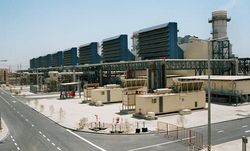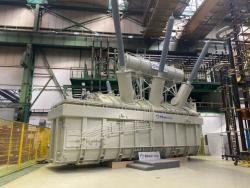
OR WAIT null SECS
© 2024 MJH Life Sciences™ and Turbomachinery Magazine. All rights reserved.
Efficiency improvement in centrifugal pumps
The downstream oil and gas industry is celebrating its first century. Developed in the USA in the early 1900s, the refining and gas processing business of today has gigantic dimensions. It possesses a high degree of technological sophistication, with rotating machinery playing a vital role.
Plant process conditions, after all, can be severe: an average-sized topping unit can provide an output capability of 1500 tons/hour. At critical process points such as furnace charge pumps, temperatures are close to 800°C.
A Fluid Catalytic Cracking (FCC) plant, for example, requires the feed mixed with the catalyst and pumped to the reactor at temperatures of around 500°C. Air required by the process is normally supplied by centrifugal or axial compressors with a flow rate of around 50000 Nm3/h and with a power output of several megawatts. Rotating machinery for compression and pumping applications often has a critical role in determining the robustness of the plant. Centrifugal pumps, in particular, are present in almost all of these plant processes.
The centrifugal pump market offers downstream process applications a wide range of size options. A large number of centrifugal pump configurations have been developed for various applications from single to multistage, axial or radial split, with a horizontal or vertical rotor position (Figure 1).
(Figure 1: A wide range of size options are available for centrifugal pumps)
The most common pump type is the horizontal one used in pressures of up to 400 bars and temperatures of up to 450°C.Vertical pumps, on the other hand, are used across a more restricted range of applications – mainly in low Net Positive Suction Head (NPSH) conditions and very low temperatures.
Technical regulations and industry standards for process industry pumps include API 610 and Hydraulic Institute codes. These provide comprehensive guidelines that drive the whole pump production process. Developed by a board of manufacturers and customers, these standards cover everything from early engineering to manufacturing.
API 610 has been subject to several revisions. For example, the criteria for evaluating pump efficiency moved from previous tolerances on efficiency to actual tolerances imposed on overall absorbed power. Vibration limits had analogous modifications,too, reflecting increasing attention on longer machine lifecycles and better energy efficiency.
Material technology has also undergone an evolution. As pumps are subject to corrosion, erosion and fatigue, material selection is a primary task in the achievement of a satisfactory machinery lifespan. Metallurgical processes, these days, enable greater control of material chemistry as in the case with duplex steels (CD4MCu) or special steel grades with precipitation hardening (17-4-PH), often used in shafts. Innovative processes such as plasma and laser coatings for sleeve surface hardening also allow better wear resistance.
Computerization
The development of the computerized Finite Element Method (FEM) has allowed better understanding of the stress field inside pump components. This has been facilitated by the greater availability of computational techniques and adequate computational powers.
As a result, modern rotating machinery design can take advantage of dedicated software tools that allow better evaluation in areas such as bearing selection, as well as balancing piston and sleeve clearance sizing.These elements, along with boundary design operative conditions, have contributed to greater rotor stability.
The introduction of Computational Fluid Dynamics (CFD) has also exerted an influence upon the development of the process pump industry. The hydraulic design of three-dimensional pump flow patterns is a delicate task. More computational power and the availability of reliable software code has allowed consistent improvement in the centrifugal pump design process, as well as the ability to integrate OEM experience withreliable simulations.
Modern CFD commercial coding has opened the door to accurate modeling of viscid (viscous) and inviscid fluids, more turbulence equations, non-stationary algorithms for the rotating regions of turbomachinery, and better designs with shorter turnaround times.
The advancement of control systems is another area that deserves mention. Recent European Community studies have demonstrated how inefficient many pump drive applications are. In the low power range, about 76% of the overall energy is absorbed (Figure 2).
(Figure 2: CFD diagram showing pressure contours)
Despite this, the concept of improving control systems for equipment in the low power pump range has received little attention when compared to large pumps where advanced control systems are currently used. This is partly due to the low ratio in terms of benefits versus costs for small size pumps i.e. more sophisticated control system would have a major impact on overall costs for small pumping stations. However, this is due to the large energy savings possible by integration of variable frequency drive (VFD) systems and auto-diagnostic control systems (Figure 3).
(Figure 3: Energy savings via improved controls can prove economic in even small scale and low power pump applications.)
Modern pump control systems enable the implementation of pump automation using a small number of field sensors. This is achievable through the implementation of performance-based models and commercial PLC. Compared to an unmonitored pump installation, slightly higher installation costs are offset by reduced maintenance and repair costs, as well as a drop in downtime.
These systems offer multivariable control so the user can set the process parameters to be controlled. The system then provides continuous and automatic monitoring of all relevant parameters. By adding a VFD drive, higher energetic efficiencies are achievable (up to 40%) when compared to traditional throttling methods. Additionally, performance-based models allow designers to predict expected performance in operative conditions. By comparing this to actual performance, control systems can be adjusted to provide accurate auto-diagnostic indications – particular anomalies such as cavitation upset, mechanical degradation and transmitters failure.
Massimiliano Di Febo, is Operation Manager at industrial Plants Construction (IPC), a firm that developed the IPC Proteo control system for pump applications.
Pasquale Paganini, is Technical Manager at IPC. For more information contact pasquale.paganini@ipc-eng.com or massimiliano.difebo@ipc-eng.com.



